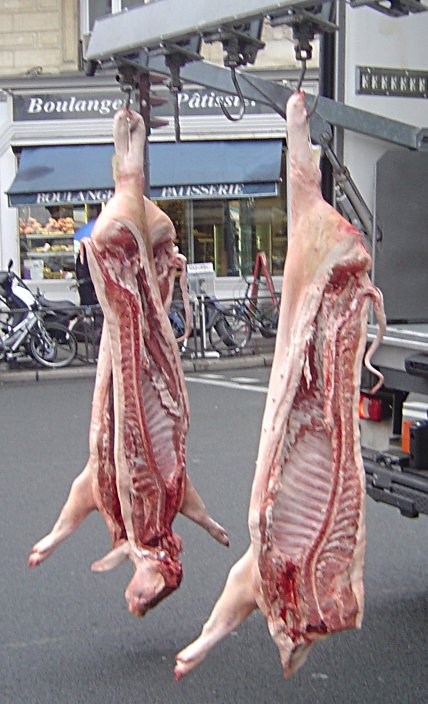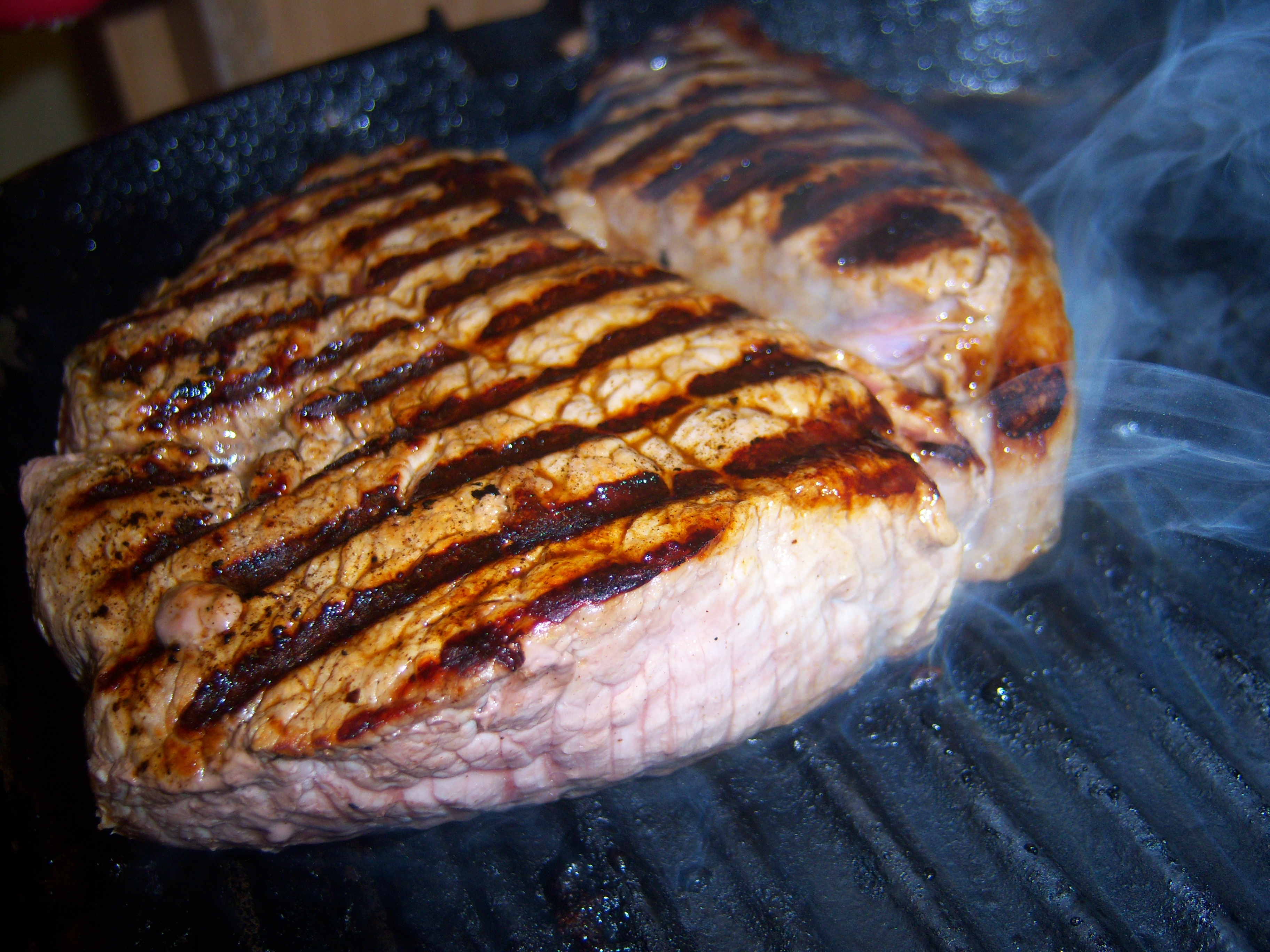|
Primal Cut
A primal cut or cut of meat is a piece of meat Meat is animal Tissue (biology), tissue, often muscle, that is eaten as food. Humans have hunted and farmed other animals for meat since prehistory. The Neolithic Revolution allowed the domestication of vertebrates, including chickens, sheep, ... initially separated from the carcass of an animal during butchering. Examples of primals include the round, loin, rib, and chuck for beef or the ham, loin, Boston butt, and picnic for pork. Different countries and cultures make these cuts in different ways, and primal cuts also differ between type of carcass. The British, American and French primal cuts all differ in some respects. For example, rump steak in British and Commonwealth English is commonly called ''sirloin'' in American English. British ''sirloin'' is called ''porterhouse'' by Americans. Another notable example is fatback, which in Europe is an important primal cut of pork, but in North America is regarded as trimmings ... [...More Info...] [...Related Items...] OR: [Wikipedia] [Google] [Baidu] |
Meat
Meat is animal Tissue (biology), tissue, often muscle, that is eaten as food. Humans have hunted and farmed other animals for meat since prehistory. The Neolithic Revolution allowed the domestication of vertebrates, including chickens, sheep, goats, pigs, horses, and cattle, starting around 11,000 years ago. Since then, selective breeding has enabled farmers to produce meat with the qualities desired by producers and consumers. Meat is mainly composed of water, protein, and fat. Its quality is affected by many factors, including the genetics, health, and nutritional status of the animal involved. Without preservation, bacteria and fungi decompose and Meat spoilage, spoil unprocessed meat within hours or days. Meat is Raw meat, edible raw, but it is mostly eaten cooked, such as by stewing or roasting, or Processed meat, processed, such as by Smoking (cooking), smoking or Salting (food), salting. The consumption of meat (especially Red meat, red and processed meat, as opposed ... [...More Info...] [...Related Items...] OR: [Wikipedia] [Google] [Baidu] |
Dressed Weight
Dressed weight (also known as dead weight or carcass weight) refers to the weight of an animal after being partially butchered, removing all the internal organs and often the head as well as inedible (or less desirable) portions of the tail and legs. It includes the bones, cartilage and other body structure still attached after this initial butchering. It is usually a fraction of the total weight of the animal, and an average of 59% of the original weight for cattle. There is no singular way to dress an animal, as what is removed depends on whether it will be cooked whole or butchered further for sale of individual parts. For pigs, the dressed weight typically includes the skin, while most other ungulates are typically dressed without. For fowl, it is calculated with skin but without feathers. It can be expressed as a percentage of the animal's live weight, when it is known as the killing out percentage. Factors affecting dressed weight The net dressed weight can vary drama ... [...More Info...] [...Related Items...] OR: [Wikipedia] [Google] [Baidu] |
Butcher
A butcher is a person who may Animal slaughter, slaughter animals, dress their flesh, sell their meat, or participate within any combination of these three tasks. They may prepare standard cuts of meat and poultry for sale in retail or wholesale food establishments. A butcher may be employed by supermarkets, grocery stores, butcher shops and fish markets, slaughter houses, or may be Self-employment, self-employed. Butchery is an ancient trade, whose duties may date back to the domestication of livestock; its practitioners formed guilds in England as far back as 1272. Since the 20th century, many countries and local jurisdictions offer Professional certification, trade certifications for butchers in order to ensure quality, safety, and health standards but not all butchers have formal certification or training. Trade qualification in English-speaking countries is often earned through an apprenticeship although some training organisations also certify their students. In Canada, onc ... [...More Info...] [...Related Items...] OR: [Wikipedia] [Google] [Baidu] |
Rump Steak
Rump steak is a cut of beef. The rump is the division between the leg and the chine cut right through the aitch bone. It may refer to: * A steak from the top half of an American-cut round steak primal * A British- or Australian-cut steak from the rump primal, largely equivalent to the American '' sirloin'' American and British equivalencies The British and Commonwealth English "rump steak" is commonly called " sirloin" in American English or Canadian English. On the other hand, British "sirloin" is called short loin or "porterhouse" by North Americans. French usage Rump steak corresponds roughly to the French cut ''culotte'' (literally 'britches'). The ''pointe de culotte'', the rump cap is highly recommended for braising as ''bœuf à la mode''. In the 20th century the English term ''rump steak'' was adopted, although with modified orthography ''romsteak'' or ''romsteck''. The spelling ''rumsteak'' is also attested.''Le Petit Larousse'', Larouss, Paris, 1994 See ... [...More Info...] [...Related Items...] OR: [Wikipedia] [Google] [Baidu] |
Fatback
Fatback is a layer of subcutaneous fat taken from under the skin of the back of a domestic pig, with or without the skin (referred to as pork rind). In cuisine Fatback is a preferred fat for various forms of charcuterie, particularly sausages and forcemeat such as quenelles. In popular culture The 1954 rhythm and blues Rhythm and blues, frequently abbreviated as R&B or R'n'B, is a genre of popular music that originated within African American communities in the 1940s. The term was originally used by record companies to describe recordings marketed predomina ... song "Fat Back and Corn Liquor" was written by Louisiana songwriter Rudy Toombs and sung by Louis Jordan. It was released by Aladdin Records as the A side of a ten-inch 78rpm record. See also * * * * '''' References External links * {{Navboxes, list1= {{Fats and oils {{Pigs {{Bacon Cuts of pork Charcuterie Soul food African-American cuisine Romani cuisine ... [...More Info...] [...Related Items...] OR: [Wikipedia] [Google] [Baidu] |
Cut Of Pork
File:British Pork Cuts.svg, 400px, British cuts of pork poly 187 219 187 194 173 196 Trotters poly 372 226 373 207 361 204 359 216 Trotters poly 171 141 166 104 287 117 294 152 Belly poly 167 102 178 27 315 23 274 102 Loin poly 361 201 371 181 394 177 373 201 Hock poly 174 191 163 182 174 173 178 184 Hock poly 387 172 372 156 371 149 387 137 407 85 368 61 370 43 328 27 315 38 302 137 343 172 Leg / Ham desc none The cuts of pork are the different parts of the pig which are consumed as food by humans. The terminology and extent of each cut varies from country to country. There are between four and six primal cuts, which are the large parts in which the pig is first cut: the shoulder (blade and picnic), loin, belly (spare ribs and side) and leg.Cattleman's Beef Board & National Cattlemen's Beef AssociationUniform Retail Meat Identity Standards. Retrieved 11 July 2007. These are often sold wholesale, as are other parts of the pig with less meat, such as the head, feet and t ... [...More Info...] [...Related Items...] OR: [Wikipedia] [Google] [Baidu] |
US Department Of Agriculture
The United States Department of Agriculture (USDA) is an executive department of the United States federal government that aims to meet the needs of commercial farming and livestock food production, promotes agricultural trade and production, works to assure food safety, protects natural resources, fosters rural communities and works to end hunger in the United States and internationally. It is headed by the secretary of agriculture, who reports directly to the president of the United States and is a member of the president's Cabinet. The current secretary is Brooke Rollins, who has served since February 13, 2025. Approximately 71% of the USDA's $213 billion budget goes towards nutrition assistance programs administered by the Food and Nutrition Service (FNS). The largest component of the FNS budget is the Supplemental Nutrition Assistance Program (formerly known as the 'Food Stamp' program), which is the cornerstone of USDA's nutrition assistance. The United State ... [...More Info...] [...Related Items...] OR: [Wikipedia] [Google] [Baidu] |
Cuts Of Beef
During butchering, beef is first divided into primal cuts, pieces of meat initially separated from the carcass. These are basic sections from which steaks and other subdivisions are cut. Since the animal's legs and neck muscles do the most work, they are the toughest; the meat becomes more tender as distance from hoof and horn increases. Different countries and cuisines have varying definitions for cuts of meat and their names, and sometimes the same name is used for different cuts. For instance, the cut described as "brisket" in the United States comes from a different part of the carcass than the "brisket" referred to in the United Kingdom. Cuts typically refer narrowly to skeletal muscle (sometimes attached to bone), but they can also include other edible parts such as offal (organ meats) or bones that are not attached to significant muscle. American and Canadian The following is a list of the American primal cuts, and cuts derived from them. Beef carcasses are split along ... [...More Info...] [...Related Items...] OR: [Wikipedia] [Google] [Baidu] |
Cuts Of Lamb
Lamb and mutton, collectively sheep meat (or sheepmeat) is one of the most common meats around the world, taken from the domestic sheep, ''Ovis aries'', and generally divided into lamb, from sheep in their first year, hogget, from sheep in their second, and mutton, from older sheep. Generally, "hogget" and "sheep meat" aren't used by consumers outside Norway, New Zealand, South Africa, Scotland, and Australia. Hogget has become more common in England, particularly in the North (Lancashire and Yorkshire) often in association with rare breed and organic farming. In South Asian cuisine, South Asian and Caribbean cuisine, Caribbean cuisine, "mutton" often means goat meat.''Oxford English Dictionary'', 3rd edition, June 2003''s.v.'', definition 1b At various times and places, "mutton" or "goat mutton" has occasionally been used to mean goat meat. Lamb is the most expensive of the three types, and in recent decades, sheep meat has increasingly only been retailed as "lamb", sometimes ... [...More Info...] [...Related Items...] OR: [Wikipedia] [Google] [Baidu] |
Cut Of Pork
File:British Pork Cuts.svg, 400px, British cuts of pork poly 187 219 187 194 173 196 Trotters poly 372 226 373 207 361 204 359 216 Trotters poly 171 141 166 104 287 117 294 152 Belly poly 167 102 178 27 315 23 274 102 Loin poly 361 201 371 181 394 177 373 201 Hock poly 174 191 163 182 174 173 178 184 Hock poly 387 172 372 156 371 149 387 137 407 85 368 61 370 43 328 27 315 38 302 137 343 172 Leg / Ham desc none The cuts of pork are the different parts of the pig which are consumed as food by humans. The terminology and extent of each cut varies from country to country. There are between four and six primal cuts, which are the large parts in which the pig is first cut: the shoulder (blade and picnic), loin, belly (spare ribs and side) and leg.Cattleman's Beef Board & National Cattlemen's Beef AssociationUniform Retail Meat Identity Standards. Retrieved 11 July 2007. These are often sold wholesale, as are other parts of the pig with less meat, such as the head, feet and t ... [...More Info...] [...Related Items...] OR: [Wikipedia] [Google] [Baidu] |





